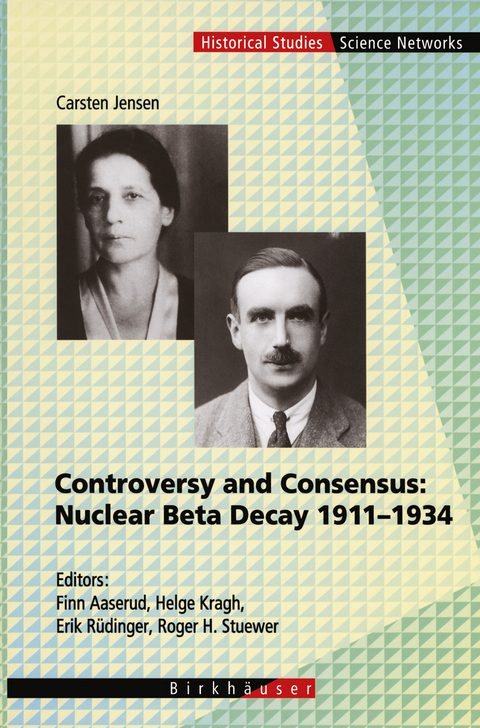
Controversy and Consensus: Nuclear Beta Decay 1911–1934
Springer Basel (Verlag)
978-3-0348-9569-9 (ISBN)
Carsten Jensen, geboren 1952, wuchs in Marstal auf. Er studierte in Kopenhagen Literaturwissenschaft und arbeitete als Journalist und Kritiker. Sein literarisches Arbeiten begann er Mitte der neunziger Jahre.
After graduation from the University of Copenhagen in Physics and Chemistry, and a period as teacher in gymnasium schools, Helge Kragh became Associate Professor at Cornell University, Departments of History and Physics. Later, he took positions as Curator at the Steno Museum for Science and Medicine and Professor of the History of Science at the University of Oslo, Norway. Since 1997, he has been Professor of the History of Science and Technology, University of Aarhus, Denmark. He is a Member of the Royal Danish Academy of Science, the International Academy for the History of Science, and of the European Academy of Science. He was President of the European Society for the History of Science (2008-10).
1 Prelude: Beta-Spectrum Research in the Pre-Nuclear Years, 1900-1911.- 1.1 Discovery and identification of the beta particle.- 1.2 The first experiments on the velocity distribution of beta particles.- 1.3 Absorption measurements question the inhomogeneity of the beta particles.- 1.4 The Hahn-Meitner vs. Wilson controversy.- 1.5 From unity to complexity: magnetic-deflection experiments, 1910-1911.- 2 The Origin of Beta Rays, and the Growing Complexity of Their Spectrum: The Rutherford Era, 1911-1919.- 2.1 Introduction.- 2.2 Rutherford's 1912 theory, and reactions to it.- 2.3 The beta particle as a nuclear constituent.- 2.4 An extreme complexity of beta line-spectra is brought to light: deflection experiments in the years 1911-1913.- 2.5 Continuity as well as lines: The composite beta spectrum.- 2.6 Rutherford's 1914 theory.- 2.7 The Bohr-Sommerfeld quantum conditions and the beta line-spectrum.- 2.8 Rutherford and the gamma rays.- 3 The Rise of a Controversy: Ellis, Meitner and Smekal Advance Different Beta-Spectrum Theories, 1920-1922.- 3.1 Introduction.- 3.2 Internal conversion, nuclear levels, and Ellis's interpretation of the beta line-spectrum.- 3.3 Analogy between alpha and beta emission, and Meitner's interpretation of the beta line-spectrum.- 3.4 Ellis's response to Meitner's hypothesis, and his interpretation of the continuous beta spectrum.- 3.5 Meitner replies to Ellis, and reveals her view on the continuous beta spectrum.- 3.6 The atom as a unity: Smekal joins the discussion, and is met with a sharp reaction.- 3.7 Two repetitions of the Chadwick experiment lead to contradictory conclusions.- 4 Secondary Effects and Order of Emission: Two Main Questions in the Controversy, 1923-1925.- 4.1 Introduction.- 4.2 Meitner investigates thebeta spectrum of UX1 and takes it as further support for her view.- 4.3 Radiationless transitions: Rosseland suggests an explanation of the emission of primary, and some secondary, beta particles.- 4.4 The nuclear field and the Compton effect: Two possible reasons for the continuous beta spectrum.- 4.5 Ellis and Skinner reinvestigate the beta line-spectra of RaB and C, and serious problems arise.- 4.6 Beta first, gamma second, or is it the other way around?.- 5 The End of the Beginning: The Controversy Enters the Decisive Phase, 1925-1929.- 5.1 Introduction.- 5.2 Ellis adjusts his view on the emission process, but maintains his interpretation of the continuous spectrum.- 5.3 The number of emitted beta particles.- 5.4 Ellis and Wooster's tour de force: A determination of the heating effect of RaE.- 5.5 Continental reactions to Ellis and Wooster's experiment.- 5.6 Some concluding remarks about the controversy.- 6 From Anomaly to Explanation: The Continuous Beta Spectrum, 1929-1934.- 6.1 Introduction.- 6.2 Non-conservation of energy or a new particle? The first phase of the Bohr-Pauli dispute, 1929-1932.- 6.3 Other attempts at explaining the anomalous continuity.- 6.4 The question of upper limits in beta spectra, and the thorium C branching problem.- 6.5 The impact of the miraculous year: The second phase of the Bohr-Pauli dispute, 1932-1933.- 6.6 The two theories of beta decay.- 7 Towards a Theory of Internal Conversion: The Beta Line-Spectrum, 1927-1934.- 7.1 Introduction.- 7.2 Experimental evidence brings about a new view on the origin of gamma rays.- 7.3 The radiation hypothesis proves insufficient to explain internal conversion of gamma rays.- 7.4 A theory of internal conversion is developed.- Summary and Conclusion.- Name Index.
"Jensen's book helps lay the foundations of a new and comprehensive history of nuclear science." (Centaurus)
| Erscheint lt. Verlag | 29.10.2012 |
|---|---|
| Reihe/Serie | Science Networks. Historical Studies |
| Zusatzinfo | XVII, 217 p. |
| Verlagsort | Basel |
| Sprache | englisch |
| Maße | 155 x 235 mm |
| Gewicht | 373 g |
| Themenwelt | Sachbuch/Ratgeber ► Natur / Technik ► Garten |
| Naturwissenschaften ► Physik / Astronomie ► Allgemeines / Lexika | |
| Schlagworte | Atom • Energy • History of Science • particles • Physics • Radiation • Spectra |
| ISBN-10 | 3-0348-9569-0 / 3034895690 |
| ISBN-13 | 978-3-0348-9569-9 / 9783034895699 |
| Zustand | Neuware |
| Haben Sie eine Frage zum Produkt? |
aus dem Bereich


